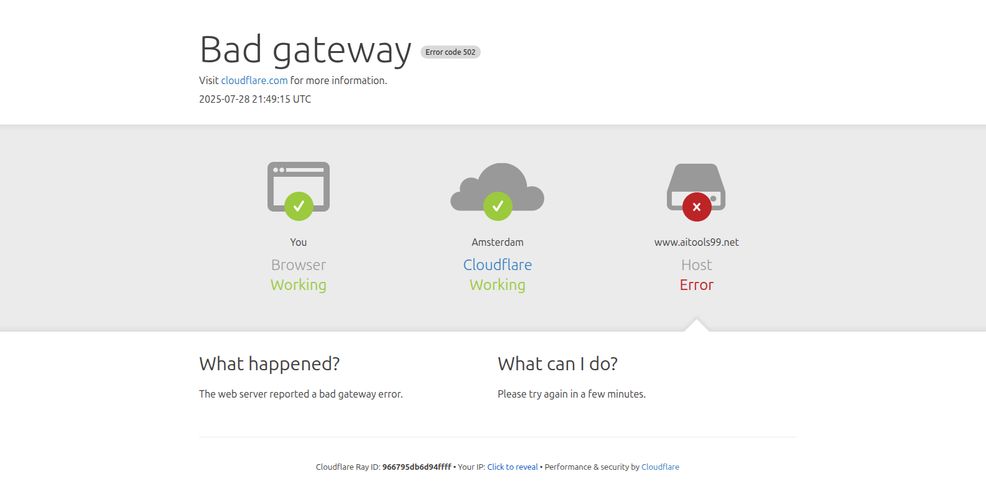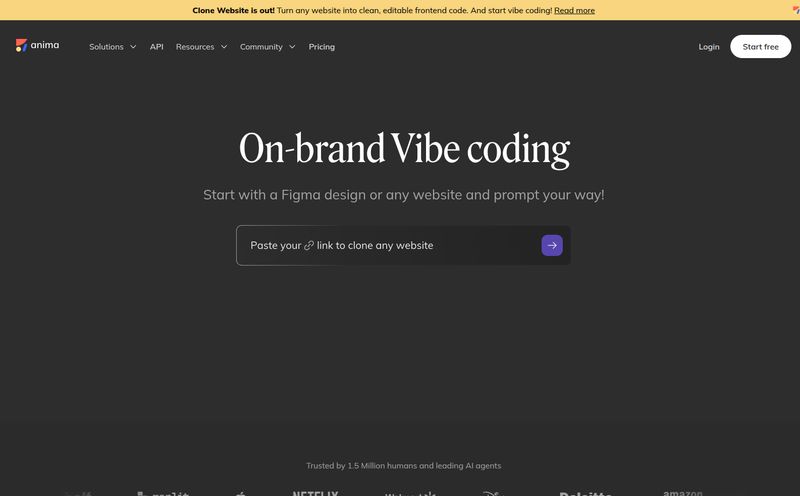Another SaaS Idea… Another Week of Tedious Setup. Or Not.
You know the feeling. That flash of brilliance at 2 AM. You’ve just mapped out the next big thing—a killer AI tool, a niche SaaS, something the world desperately needs. You're buzzing. You fire up your code editor, ready to build the future. And then... reality hits.
Authentication. User databases. Setting up payments. Connecting to Stripe’s API and wrestling with webhooks. Building a decent-looking landing page. SEO tags. Ugh. Suddenly your brilliant idea is buried under a mountain of boilerplate chores. That initial spark of excitement? It’s flickering, man.
I’ve been there more times than I care to admit. The graveyard of my side projects is filled with ideas that died, not because they were bad, but because the setup friction was just too much. It’s the plumbing of web development, and nobody gets excited about plumbing. That’s why when I stumbled across Next Starter AI, I was intrigued. Skeptical, but intrigued.
So What Exactly Is Next Starter AI?
In short, Next Starter AI is a pre-built foundation for your next web application. It’s a Next.js boilerplate, built with Typescript, that bundles together all those necessary but soul-crushing startup tasks into a single package you can get running in minutes. Think of it less as a restrictive template and more as a professional-grade launchpad.
The whole promise is to take you from idea to launch in days, not weeks. And for any indie hacker, solopreneur, or small team, that's… well, that’s everything. Time is the one resource you can’t get more of.
This isn’t for the person who wants to learn how to set up OAuth from scratch. This is for the person who’s done it ten times and would rather spend their weekend actually building the features that will make them money.
The Time-Suck Problem It Actually Solves
Let's get real. The folks behind Next Starter AI claim their kit saves you at least 37+ hours of work. At first, I scoffed. Sounds like marketing fluff. But then I started mentally adding up the hours from my last project…
- Designing a landing page that doesn't look like it's from 2005? 15 hours, easily.
- Setting up Stripe or Lemon Squeezy, handling checkout sessions, and making sure the webhooks don't fail silently in the middle of teh night? Oh boy. That's a 15-hour rabbit hole right there.
- Authentication? Protected routes? Magic links? Another few hours.
Suddenly, 37 hours starts to sound… conservative. It’s not just the coding time; it’s the time spent debugging, searching Stack Overflow, and questioning your life choices. This boilerplate is designed to hand you all of that on a silver platter, letting you get straight to the good stuff.

Visit Next Starter AI
Let's Look Under the Hood at the Features
A boilerplate is only as good as its parts. So what are you actually getting? It's like a well-stocked toolbox for modern web apps.
The Core Tech Stack
The foundation is solid and, frankly, exactly what I’d choose for a new project today. You're getting Next.js for the framework, which is the gold standard for React development. It’s all written in Typescript, which saves you from a world of runtime errors. And for styling? It uses Tailwind CSS, so you can build beautiful, custom UIs without writing a single line of traditional CSS if you dont want to.
Handling Payments with Stripe and Lemon Squeezy
This is a huge one. It comes with pre-built integrations for both Stripe and Lemon Squeezy. This isn't just a link to their docs; it's the checkout flows, the webhook handling to update user subscriptions, and all the little bits that are shockingly complicated to get right. This alone could justify the price for many.
Authentication and Database with Supabase
User management is another one of those 'solved problems' that is still a pain to implement. Next Starter AI uses Supabase for its database and authentication. This means you get user sign-ups, Google OAuth, and password-less magic links right out of the box. Supabase is a fantastic, developer-friendly alternative to Firebase, and seeing it integrated so cleanly is a big plus.
Built-in SEO and Marketing Tools
As an SEO guy, this made my ears perk up. Most boilerplates are built by developers for developers. Marketing is an afterthought. But here, you get a marketing guide, a pre-built blog section ready for your content, and all the necessary SEO tags (meta titles, descriptions, OG tags) handled for you. They even help you with Google Analytics and Tag Manager setup. That shows they're not just thinking about building the app, but also about getting it seen.
AI Integrations Ready to Go
Given the name, you'd expect some AI goodies. It comes with API integrations for Runpod & Replicate, making it easier to hook into various AI models. It also includes some slick UI components like a canvas for image generation apps and a styled prompt input. It’s clearly built with the current AI gold rush in mind.
How Much Does This Shortcut Cost? The Pricing Breakdown
Alright, let's talk money. The value proposition here is trading a one-time fee for dozens, if not hundreds, of your hours back. The pricing is refreshingly simple with a "pay once, use forever" model. No subscriptions. I love that.
| Plan | Price (One-Time) | Key Features |
|---|---|---|
| Standart Starter Pack | $169 | Includes the NextJs boilerplate, landing page components, payment integrations, SEO guide, Supabase, AI integrations, lifetime updates, and more. |
| Pro All In | $199 | Includes everything in the Standard pack. Honestly, the feature list looks identical, so this might be for priority support or future pro-level features. For $30 extra, it's probably a safe bet. |
| Custom Plan | Contact for quote | For when you need a dedicated team to build a fully custom project for you. |
The lifetime updates promise is huge. The web changes fast, and knowing you'll get updates to keep the boilerplate current adds a lot of long-term value.
The Good, The Bad, and The Code-y
No tool is perfect. Let's be real. Some people might argue that a boilerplate can lock you into certain technologies or patterns. And they're not wrong. If you despise Supabase and want to use MongoDB, you'll have some work to do. But that's the trade-off. You're buying speed and convenience.
The biggest 'con', if you can call it that, is that this is not a no-code tool. You need to be comfortable with React, Next.js, and at least be willing to get your hands dirty with code. It's a starter for developers, not a replacement for them.
But the good stuff? It's a long list. The code quality seems solid based on the testimonials, the feature set is incredibly comprehensive, and the focus on not just development but also marketing and SEO is a rare and beautiful thing to see.
Real Talk from Real Developers
The site is plastered with testimonials on Twitter/X, which is a good sign. People seem genuinely happy. A user named TofuCat1804 mentioned it helped him get to earning $4000+ per month, saying it saved him time and allowed him to focus on his actual product. That's a powerful story.
Another, Gregory Karlo, called it a "game-changer for developers." When you see this kind of feedback from your peers, it definitely makes you feel more confident that you're not just buying a pile of code that will be abandoned in six months.
My Final Verdict: Is Next Starter AI Worth Your Money?
So, here's my take. If you're an experienced developer who genuinely enjoys the process of setting everything up from a blank folder, this might not be for you. You like the control. I get it.
But if you are an indie maker, a founder, or a developer who values your time and wants to focus on building unique features rather than reinventing the wheel, then yes. Absolutely. For less than $200, you are buying back a full week of your life. Maybe more. It allows you to maintain that initial momentum and excitement for your project, which is often the difference between shipping and ending up in the project graveyard.
It's an investment in speed. And in the world of startups, speed is everything.
Conclusion
We've all got a finite amount of time and energy. Tools like Next Starter AI are exciting because they allow us to spend those precious resources on what truly matters: creativity, innovation, and building things that people love to use. Stop building the plumbing and go decorate the house. This boilerplate hands you the keys so you can get started right away.
Frequently Asked Questions
- Is this boilerplate beginner-friendly?
- It's more for developers who have some experience with Javascript and React/Next.js. A complete beginner might find it overwhelming. It's a 'code' tool, not a 'no-code' one. You'll need to be comfortable in a code editor.
- Can I customize the design and features?
- Yes, absolutely. That's the point. It gives you a fully functional, clean foundation. You have 100% access to the code to change anything and everything, from the color scheme to the database logic.
- What's the deal with lifetime updates?
- The one-time purchase price includes lifetime updates. This means as Next.js evolves or new best practices emerge, you'll get updated versions of the boilerplate, which is a fantastic value.
- Is it only for building AI applications?
- Not at all. While it has great AI integrations, the core is a rock-solid SaaS boilerplate. You can use it to build any kind of subscription software, a simple web app, a micro-SaaS, or a marketplace. The AI stuff is just a very timely bonus.
- Why not just use a free boilerplate from GitHub?
- You could, but free boilerplates are often less comprehensive, may not be actively maintained, and rarely include the level of integration (payments, SEO, marketing guides) and support that a premium product like this offers. You're paying for a more complete, reliable, and thought-out solution.



